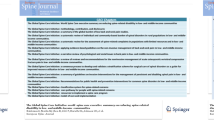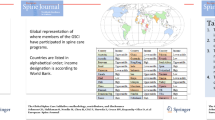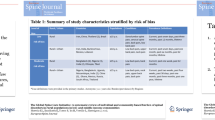Abstract
Purpose
The purpose of this systematic literature review was to develop recommendations for the assessment of spine-related complaints in medically underserved areas with limited resources.
Methods
We conducted a systematic review and best evidence synthesis of guidelines on the assessment of spine-related complaints. Independent reviewers critically appraised eligible guidelines using the Appraisal of Guidelines for Research and Evaluation-II criteria. Low risk of bias clinical practice guidelines was used to develop recommendations. In accordance with the mandate of the Global Spinal Care Initiative (GSCI), recommendations were selected that could be applied to medically underserved areas and low- and middle-income countries by considering the limited access and costs of diagnostic technologies.
Results
We screened 3069 citations; 20 guidelines were eligible for critical appraisal. We used 13 that had a low risk of bias that targeted neck and back pain.
Conclusions
When assessing patients with spine-related complaints in medically underserved areas and low- and middle-income countries, we recommend that clinicians should: (1) take a clinical history to determine signs or symptoms suggesting serious pathology (red flags) and psychological factors (yellow flags); (2) perform a physical examination (musculoskeletal and neurological); (3) do not routinely obtain diagnostic imaging; (4) obtain diagnostic imaging and/or laboratory tests when serious pathologies are suspected, and/or presence of progressive neurologic deficits, and/or disabling persistent pain; (5) do not perform electromyography or nerve conduction studies for diagnosis of intervertebral disc disease with radiculopathy; and (6) do not perform discography for the assessment of spinal disorders. This information can be used to inform the GSCI care pathway and model of care.
Graphical abstract
These slides can be retrieved under Electronic Supplementary Material.


Similar content being viewed by others
References
Connelly LBW, Brooks P (2006) Cost-effectiveness of interventions for musculoskeletal conditions. In: Jamison DB, Measham AR et al (eds) Disease control priorities in developing countries, 2nd edn. World Bank, Washington DC
Haldeman S et al (2012) Advancements in the management of spine disorders. Best Pract Res Clin Rheumatol 26(2):263–280
National Collaborating Centre for Primary Care (2009) National Institute for Health and Clinical Excellence: guidance, in low back pain: early management of persistent non-specific low back pain. Royal College of General Practitioners, London
Youssef JA et al (2013) Current status of adult spinal deformity. Global Spine J 3(1):51–62
Hoy D et al (2014) The global burden of low back pain: estimates from the Global Burden of Disease 2010 study. Ann Rheum Dis 73(6):975–981
Fejer R, Kyvik KO, Hartvigsen J (2006) The prevalence of neck pain in the world population: a systematic critical review of the literature. Eur Spine J 15(6):834–848
Global Burden of Disease Study (2015) Collaborators (2016) Global, regional, and national incidence, prevalence, and years lived with disability for 310 diseases and injuries, 1990–2015: a systematic analysis for the Global Burden of Disease Study 2015. Lancet 388(10053):1545–1602
Hoy D et al (2014) The global burden of neck pain: estimates from the global burden of disease 2010 study. Ann Rheum Dis 73(7):1309–1315
Sackett DL (1997) Evidence-based medicine. Semin Perinatol 21(1):3–5
Hurwitz EL et al (2008) Treatment of neck pain: noninvasive interventions: results of the Bone and Joint Decade 2000–2010 Task Force on Neck Pain and Its Associated Disorders. Spine 33(4 Suppl):S123–S152
Haldeman S, Dagenais S (2008) A supermarket approach to the evidence-informed management of chronic low back pain. Spine J 8(1):1–7
Dagenais S, Tricco AC, Haldeman S (2010) Synthesis of recommendations for the assessment and management of low back pain from recent clinical practice guidelines. Spine J 10(6):514–529
Kung J, Miller RR, Mackowiak PA (2012) Failure of clinical practice guidelines to meet institute of medicine standards: two more decades of little, if any, progress. Arch Intern Med 2012:1–6
Global Spine Care Initiative. http://www.globalspinecareinitiative.org/ (cited 6 July 2016)
McGowan J, Sampson M, Lefebvre C (2010) An evidence based checklist for the peer review of electronic search strategies (PRESS EBC). Evid Based Libr Inf Pract 5(1):149–154
Sampson M et al (2009) An evidence-based practice guideline for the peer review of electronic search strategies. J Clin Epidemiol 62(9):944–952
Qaseem A et al (2010) The development of clinical practice guidelines and guidance statements of the American College of Physicians: summary of methods. Ann Intern Med 153(3):194–199
Clark E, Donovan EF, Schoettker P (2006) From outdated to updated, keeping clinical guidelines valid. Int J Qual Health Care 18(3):165–166
Nordin M et al (2008) Assessment of neck pain and its associated disorders: results of the bone and joint decade 2000–2010 task force on neck pain and its associated disorders. Eur Spine J 17(Suppl 1):101–122
American Academy of Orthopaedic Surgeons. Spinal injections. 2013. http://orthoinfo.aaos.org/topic.cfm?topic=A00560 (cited 15 Dec 2016)
Saal JS (2002) General principles of diagnostic testing as related to painful lumbar spine disorders: a critical appraisal of current diagnostic techniques. Spine 27(22):2538–2545 (discussion 2546)
Brouwers MC et al (2010) AGREE II: advancing guideline development, reporting and evaluation in health care. CMAJ 182(18):E839–E842
Brouwers MC et al (2010) Development of the AGREE II, part 2: assessment of validity of items and tools to support application. CMAJ 182(10):E472–E478
Cutforth G, Peter A, Taenzer P (2011) The Alberta Health Technology Assessment (HTA) Ambassador Program: the development of a contextually relevant, multidisciplinary clinical practice guideline for non-specific low back pain: a review. Physiother Can 63(3):278–286
Moher D et al (2009) Preferred reporting items for systematic reviews and meta-analyses: the PRISMA statement. BMJ 339:b2535
Feinstein AR, Cicchetti DV (1990) High agreement but low kappa: I. The problems of two paradoxes. J Clin Epidemiol 43(6):543–549
Manchikanti L et al (2013) An update of comprehensive evidence-based guidelines for interventional techniques in chronic spinal pain. Part II: guidance and recommendations. Pain Physician 16(2 Suppl):S49–S283
Daffner RH, Wippold FJ II, Angtuaco EJ, Appel M, Berger KL, Cornelius RS, Douglas AC, Fries IB, Hayes CW, Holly L, Mechtler LL, Prall JA, Rubin DA, Ward RJ, Waxman AD (2012) Expert Panels on Musculoskeletal and Neurologic Imaging, ACR Appropriateness Criteria® suspected spine trauma. American College of Radiology, Reston
American College of Occupational and Environmental Medicine (2016) Cervical and thoracic spine disorders. In: Hegmann KT (ed) Occupational medicine practice guidelines. Evaluation and management of common health problems and functional recovery in workers, 3rd edn. Reed Group Ltd, Westminster
American College of Occupational and Environmental Medicine (2011) Low back disorders. In: Hegmann KT (ed) Occupational medicine practice guidelines. Evaluation and management of common health problems and functional recovery in workers, 3rd edn. ACOEM, Elk Grove Village
Work Loss Data Institute (2013) Neck and upper back (acute and chronic) [withdrawn]. Work Loss Data Institute, Encinitas
Institute Work Loss Data, Institute Work Loss Data (2013) Low back—lumbar and thoracic (acute and chronic) [withdrawn]. Work Loss Data Institute, Encinitas
Chou RQ et al (2011) Diagnostic imaging for low back pain: advice for high-value health care from the American College of Physicians. [Erratum appears in Ann Intern Med. 2012 Jan 3;156(1 Pt 1):71], [Summary for patients in Ann Intern Med. 2011 Feb 1;154(3):I36]. Ann Intern Med 154(3):181–189
North American Spine Society (2012) Diagnosis and treatment of lumbar disc herniation with radiculopathy. North American Spine Society, Burr Ridge
North American Spine Society (2014) Evidence-based clinical guidelines for multidisciplinary spine care. Diagnosis and treatment of adult isthmic spondylolisthesis. North American Spine Society, Burr Ridge
Patel ND et al (2016) ACR appropriateness criteria low back pain. J Am Coll Radiol 13(9):1069–1078
Chung SM, Wales PW, Dirks P, Shroff M, Singhal A, Grant V, Hancock BJ, Creery D, Atkinson J, St-Vil D, Crevier L, Yanchar N, Hayashi A, Mehta V, Carey T, Dhanani S, Siemens R, Singh S, Price D (2011) Trauma association of Canada Pediatric Subcommittee National Pediatric Cervical Spine Evaluation Pathway: consensus guidelines. J Trauma Injury Infect Crit Care 70(4):873–884
Livingston C et al. (2011) Evidence-based clinical guidelines project Evaluation and management of low back pain: a clinical practice guideline based on the joint practice guideline of the American College of Physicians and the American Pain Society (diagnosis and treatment of low back pain). Office for Oregon Health Policy and Research, Salem
Newman JS, Angevine PD, Appel M, Arnold E, Bencardino JT, Fries IB, Hayes CW, Hochman MG, Holly LT, Jacobson JA, Math KR, Murphey MD, O’Toole JE, Rubin DA, Scharf SC, Small KM, Expert Panel on Musculoskeletal Imaging (2013) ACR Appropriateness Criteria® chronic neck pain. American College of Radiology (ACR), Reston
Delitto AG, Van Dillen LR, Whitman JM, Sowa G, Shekelle P, Denninger TR, Godges JJ (2012) Low back pain. J Orthop Sports Phys Ther 42(4):A1–A57
Philippine Academy of Rehabilitation Medicine (PARM) (2012) Clinical practice guidelines on the diagnosis and management of low back pain (CPG 2011). http://parm.com.ph/wp-content/uploads/2016/09/PARM-Low-Back-Pain-CPG-2011-1.pdf (26 March 2016)
Juanola Roura X et al (2015) Recommendations for the detection, study and referral of inflammatory low-back pain in primary care. Rheumatol Clin 11(2):90–98
AIM Specialty Health (2017) Clinical Appropriateness Guidelines: Advanced Imaging. Appropriate use criteria: imaging of the spine. AIM Specialty Health, Chicago IL, USA. https://aimspecialtyhealth.com/PDF/Guidelines/2017/Sept05/AIM_Guidelines_Spine.pdf (cited October 5, 2017)
Thwaites G et al (2009) British Infection Society guidelines for the diagnosis and treatment of tuberculosis of the central nervous system in adults and children. J Infect 59(3):167–187
Berbari EF et al (2015) Clinical practice guidelines for the diagnosis and treatment of native vertebral osteomyelitis in adults. Clin Infect Dis 61(6):e26–e46
Picelli A et al (2016) Headache, low back pain, other nociceptive and mixed pain conditions in neurorehabilitation Evidence and recommendations from the Italian Consensus Conference on Pain in Neurorehabilitation. Eur J Phys Rehabil Med 52(6):867–880
Hatala RSS, Kane S, Cook DJ, O’Meade M, Nishikawa J (1997) An evidence-based approach to the clinical examination. J Gen Intern Med 12(3):182–187
Bach SM, Holten KB (2009) Guideline update: what’s the best approach to acute low back pain? J Fam Pract 58(12):E1
Chou R et al (2007) Diagnosis and treatment of low back pain: a joint clinical practice guideline from the American College of Physicians and the American Pain Society. Ann Intern Med 147(7):478–491
Campbell E (1990) Physical examination, chapter 4. In: Hurst JW (ed) Clinical method: the history, physical and laboratory examinations. Butterworths, Boston
National Institutes of Health (2016) MedlinePlus. Diagnostic imaging. https://www.nlm.nih.gov/medlineplus/diagnosticimaging.html (cited 8 July 2016)
Schellhas KP et al (1996) Cervical discogenic pain. Prospective correlation of magnetic resonance imaging and discography in asymptomatic subjects and pain sufferers. Spine 21(3):300–311 (discussion 311–312)
Agency for Health Care Policy and Research (1994) Acute low back problems in adults: assessment and treatment. Clin Pract Guidel Quick Ref Guide Clin 14:iii–iv, 1–25
Amtmann D et al (2010) Development of a PROMIS item bank to measure pain interference. Pain 150(1):173–182
Cedraschi C, Nordin M, Haldeman S, Randhawa K, Kopansky-Giles D, Johnson CD et al (2018) The Global Spine Care Initiative: a narrative review of psychological and social issues in back pain in low- and middle-income communities. Eur Spine J https://doi.org/10.1007/s00586-017-5434-7
New Zealand Guidelines Group (2004) Accident Compensation Corporation, New Zealand Acute Low Back Pain Guide: incorporating the guide to assessing psychosocial yellow flags in acute low back pain. New Zealand Guidelines Group, Wellington
Linton SJ, Nicholas M, MacDonald S (2011) Development of a short form of the Orebro Musculoskeletal Pain Screening Questionnaire. Spine 36(22):1891–1895
Akena D et al (2013) Sensitivity and specificity of clinician administered screening instruments in detecting depression among HIV-positive individuals in Uganda. AIDS Care 25(10):1245–1252
Fairbank JC et al (1980) The Oswestry low back pain disability questionnaire. Physiotherapy 66(8):271–273
Costa LO, Maher CG, Latimer J (2007) Self-report outcome measures for low back pain: searching for international cross-cultural adaptations. Spine 32(9):1028–1037
Maher C, Latimer J, Costa L (2007) The relevance of cross-cultural adaptation and clinimetrics for physical therapy instruments. Braz J Phys Ther 11:245–252
New Zealand Guidelines Group (2004) Accident Compensation Corporation. New Zealand Acute Low Back Pain Guide: incorporating the guide to assessing psychosocial yellow flags in acute low back pain
Deyo RA et al (2014) Report of the NIH Task Force on research standards for chronic low back pain. J Pain 15(6):569–585
Nicholas MK et al (2011) Early identification and management of psychological risk factors (“yellow flags”) in patients with low back pain: a reappraisal. Phys Ther 91(5):737–753
Lowe B et al (2010) A 4-item measure of depression and anxiety: validation and standardization of the Patient Health Questionnaire-4 (PHQ-4) in the general population. J Affect Disord 122(1–2):86–95
United Nations Scientific Committee on the Effects of Atomic Radiation (2008) UNSCEAR 2008 report, vol 1. UNSCEAR, Vienna
World Health Organization (2010) Baseline country survey on medical devices. WHO, Geneva
Johnson AP et al (2009) Health technology assessment: a comprehensive framework for evidence-based recommendations in Ontario. Int J Technol Assess Health Care 25(2):141–150
Acknowledgements
We thank Leslie Verville and Geoff Outerbridge for their contributions to this paper.
Funding
The Global Spine Care Initiative and this study were funded by grants from the Skoll Foundation and NCMIC Foundation. World Spine Care provided financial management for this project. The funders had no role in study design, analysis, or preparation of this paper.
Author information
Authors and Affiliations
Corresponding author
Ethics declarations
Conflict of interest
MN declares funding from Skoll Foundation and NCMIC Foundation through World Spine Care; Co-Chair, World Spine Care Research Committee. Palladian Health, Clinical Policy Advisory Board member. Book Royalties Wolters Kluwer and Springer. Honoraria for speaking at research method courses. KR declares funding to UOIT from Skoll Foundation, NCMIC Foundation through World Spine Care. PT declares no COI. HY declares funding to UOIT from Skoll Foundation, NCMIC Foundation through World Spine Care. SH declares funding to UOIT from Skoll Foundation, NCMIC Foundation through World Spine Care. Clinical Policy Advisory Board and stock holder, Palladian Health. Advisory Board, SpineHealth.com. Book Royalties, McGraw Hill. Travel expense reimbursement—CMCC Board. OB declares he is a consultant for: Pacira Pharmaceuticals, Inc. Palladian Health. Travel expenses: World Spine Care. Stipend: World Spine Care. PC is funded by a Canada Research Chair in Disability Prevention and Rehabilitation at the University of Ontario Institute of Technology, and declares funding to UOIT from Skoll Foundation, NCMIC Foundation through World Spine Care. Canadian Institutes of Health Research Canada. Research Chair Ontario Ministry of Finance. Financial Services Commission of Ontario. Ontario Trillium Foundation, ELIB Mitac. Fond de Recherche and Sante du Quebec. CT declares no COI. MM declares no COI. RM declares no COI. CC declares no COI. RC declares funding from AHRQ to conduct systematic reviews on treatments for low back pain within last 2 years. Honoraria for speaking at numerous meetings of professional societies and non-profit groups on topics related to low back pain (no industry sponsored talks). EAc declares grants: Depuy Synthes Spine, Medtronic; Speaker’s bureau: AOSpine, Zimmer Biomet. EH declares he is a consultant for: RAND Corporation; EBSCO Information Services; Southern California University of Health Sciences; Western University of Health Sciences Data and Safety Monitoring Committee. Chair, Palmer Center for Chiropractic Research. Research Committee Co-chair, World Spine Care. NL declares no COI. JD declares no COI. ATV declares funding to UOIT from Skoll Foundation, NCMIC Foundation through World Spine Care. ES declares funding from Başkent University Research Fund.
Electronic supplementary material
Below is the link to the electronic supplementary material.
Rights and permissions
About this article
Cite this article
Nordin, M., Randhawa, K., Torres, P. et al. The Global Spine Care Initiative: a systematic review for the assessment of spine-related complaints in populations with limited resources and in low- and middle-income communities. Eur Spine J 27 (Suppl 6), 816–827 (2018). https://doi.org/10.1007/s00586-017-5446-3
Received:
Revised:
Accepted:
Published:
Issue Date:
DOI: https://doi.org/10.1007/s00586-017-5446-3






